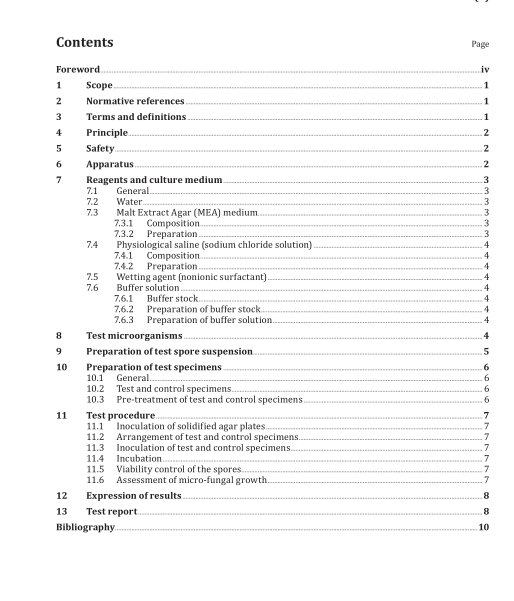ISO 19574:2022 pdf download.Footwear and footwear components — Qualitative test method to assess antifungal activity (growth test)
4 Principle
The test and control specimens of footwear are inoculated with a mixed spore suspension of selected mould test strains or with a single test strain according to the specific claim.
Antifungal performance is qualitatively determined by visual assessment of fungal growth after specified or agreed incubation period.
5 Safety
Handling of microorganisms that are potentially hazardous requires a high degree of technical competence and can be subject to current national legislation and regulations. Only personnel trained in microbiological techniques should carry out such tests.
NOTE Refer to country-specific codes of practice for personal hygiene, disinfection and sterilization.
The persons who perform the test should consult IEC 60068-2-10:2005+AMD1: 2018, Annex A and ISO 7218.
6 Apparatus
6.1 General
Disposable apparatus is an acceptable alternative to re-usable glassware and plastic if it has suitable specifications.
The usual microbiological laboratory equipment in accordance with ISO 7218 and in particular the following shall be used.
6.2 Biological safety cabinet.
6.3 Microbiological incubator, capable of maintaining a temperature of (28 ± 2) °C and a relative humidity of (85 ± 5) %.
6.4 Autoclave capable of maintaining a temperature of (121 ± 2) °C and a pressure of (103 ± 5) kPa,for wet sterilization, used in accordance with ISO 7218.
6.5 Vortex mixer.
6.6 pH-meter, having an accuracy of ±0,1 pH-units.
6.7 Laboratory centrifuge, 2 000g.
NOTE 2 000g ≈ 4 000 r/min.
6.8 Microscope, at least magnification × 20 (better magnification × 50).
6.9 Glass beads, 2 mm to 3 mm in diameter, for preparation of fungal spore suspension.
6.10 Glass wool or medical gauze (double layers), for preparation of fungal spore suspension.
6.11 Wide mouth jars, with cap, 500 ml, capable of being used with an autoclave (6.4).
6.12 Oven, for dry sterilization.
6.13? Balance, capable of weighing to ±0,01 g.
6.14? Spectrophotometer, capable of measuring at 500 nm to 700 nm wavelength, or McFarland’s nephelometer.
6.15? Petri? dishes, that have been sterilized, made of glass or plastic, in diameter sizes of 90 mm to 100 mm or 55 mm to 60 mm.
6.16? Pipettes, having the most suitable volume for each use.
6.17? Grid, for evaluation of fungal growth, each square has a size of 5 mm × 5 mm, or that divides the surface of the test specimen into 100 equal sized squares.
7 Reagents and culture medium
7.1? General
The reagents used in the tests shall be of analytical quality and/or suited for microbiological purposes.
Dehydrated products available on the commercial market should be used in the preparation of the culture media. The manufacturer’s instructions for the preparation of these products should be strictly followed.
The preparation, production and performance testing of culture media shall be in accordance with ISO 11133.
7.2 Water
The water used in the tests shall be analytical-grade water for microbiological media preparation,which is freshly distilled and/or ion-exchanged and/or ultra-filtered and/or filtered with RO (Reverse Osmosis).
It shall be free from all toxic or microorganism inhibitory substances.
7.3 Malt Extract Agar (MEA) medium
7.3.1 Composition
Malt extract 30,0 g
Soya peptone 3,0 g
Agar 15,0 g
Water 1 000 ml
7.3.2 Preparation
After mixing, stir and adjust the pH to (5,5 ± 0,2) at room temperature. Heat with stirring on a hotplate or in a boiling-water bath until the components are completely dissolved, sterilize at (121 ± 2) °C for 15 min in an autoclave (6.4) with saturated water vapour. Cool and shake solution well, then pour 25 ml into each sterile Petri dish. Leave to cool and solidify.
NOTE 1 The Potato Dextrose Agar (PDA) can also provide a complete medium for the growth of micro-fungi.
The PDA medium with standard composition can be obtained from commercial source.
NOTE 2 MEA medium can be obtained from commercial source.
7.4 Physiological saline (sodium chloride solution)
7.4.1 Composition
Sodium chloride (NaCl), CAS RN® 1) : 7647-14-5 8,5 g
Water
1 000 ml
7.4.2 Preparation
After mixing well, adjust pH to (6,9 ± 0,2) at room temperature and sterilize at (121 ± 2) °C for 15 min.
7.5 Wetting agent (nonionic surfactant)
The wetting agent shall be used to harvest the spores in the test spore suspension. It should not react with other reagents and not cause a reduction or increase in micro-fungi number, such as polysorbate 80 (TWEEN 80), N-methyltauride, Triton TM X-100 2) or polyglycol ether, etc. Use final concentrations of 0,01 %.
NOTE Wetting agent (nonionic surfactant) can be used in the test when the specimens have coating.ISO 19574 pdf download.ISO 19574 pdf download
